Understanding your results
Overview
The Predictive Index was founded over 70 years ago with an ambitious mission: Better Work, Better World. Our passion, inherited from our founder Arnold Daniels, is to understand people and teams—specifically what drives behaviors at work. Like you, we strive to understand that behavior and ignite enthusiasm in your people.
Our software hones the wisdom, guidance, and data that help inspire employees to be the most productive, engaged, and self-aware professionals they can be.
Patterns
The primary result of the PI Behavioral Assessment™️, and the engine behind many of the insights you see about a person, is a pattern. The pattern is made up of Factors, which shed light on the amount and intensity key behavioral drives to help predict and understand workplace behavior.
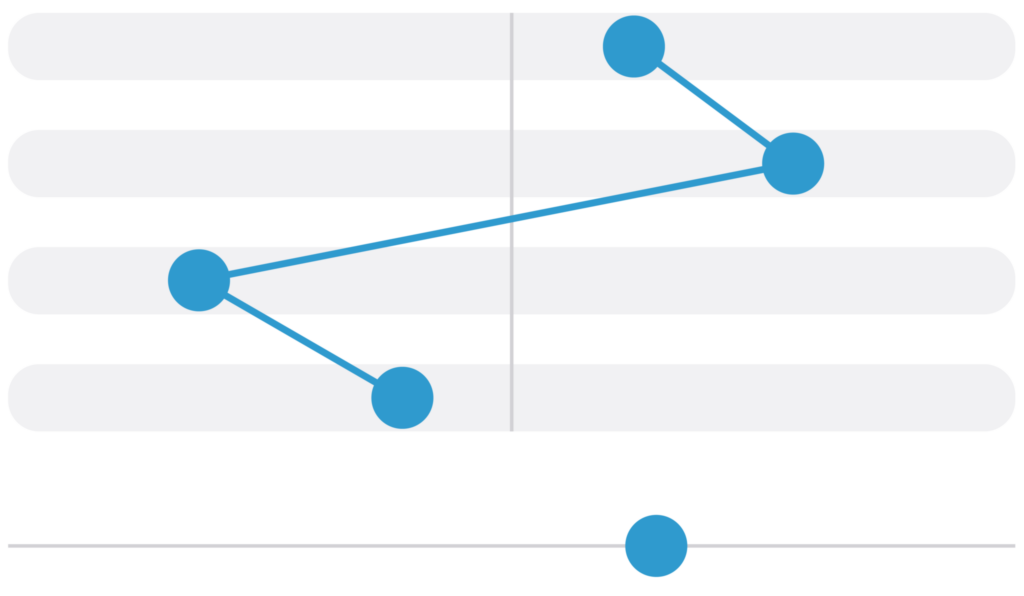
Snapshot
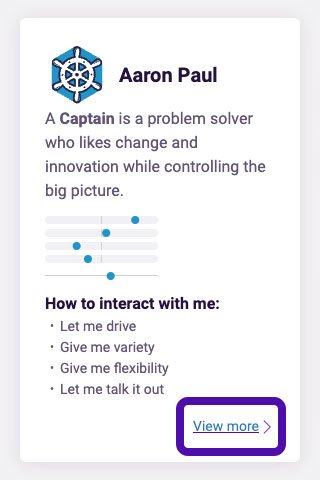
A Snapshot is created for anyone who completes the Behavioral Assessment™️ and can be found by clicking View more > from the Person page.
The snapshot provides a summary of the person’s results, including their Reference Profile, pattern, preferred work style, strengths, caution areas, and Factor Combinations.
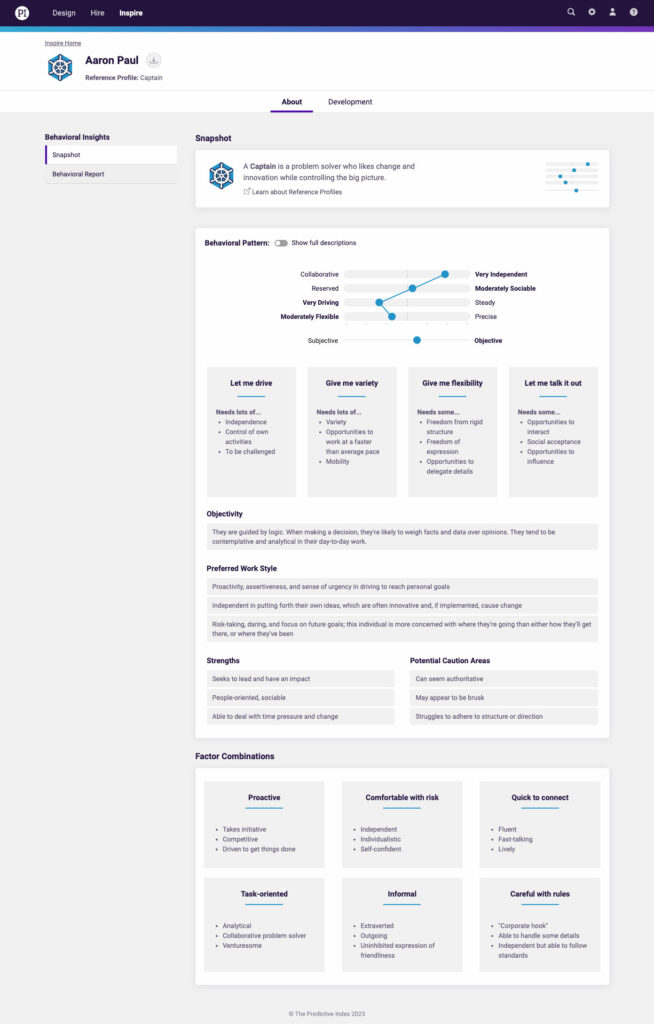
Self and Self-Concept
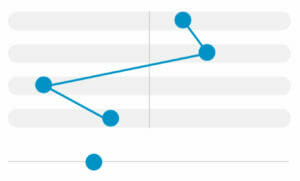
The data and insights you see in our product primarily use what we call the Self Awareness pattern. That’s because it’s the most important! It describes your true self — your most natural workplace behaviors — the person that you described when you were taking the Behavioral Assessment and selected the words “that you yourself believe really describe you.”
But, there are times when you’ll see and use the information that includes an additional pattern, Self-Concept, which is created from the words you selected to describe “the way you are expected to act by others.”
Both the Self and Self-Concept patterns are a result of the same Behavioral Assessment.
In an ideal world, your internal drives and external demands would be perfectly aligned. But workplaces are rarely that simple, and people often feel expected to work in ways that run counter to their natural strengths.
Self-Concept shows how a person perceives the external demands of their work environment.
Seeing differences in Self and Self-Concept can give you insight into how someone is trying to balance their expected behavior versus what comes most natural to them. If the patterns are close, they may not need to spend a lot of energy meeting the expectations of the role. Where they differ can indicate where a person may be adapting to meet expectations.
Knowing this can potentially help facilitate conversations around important areas that align with Inspire, such as inclusion, development, and “stretching” one’s factors in productive/positive ways.
Let’s take a look at the example below.
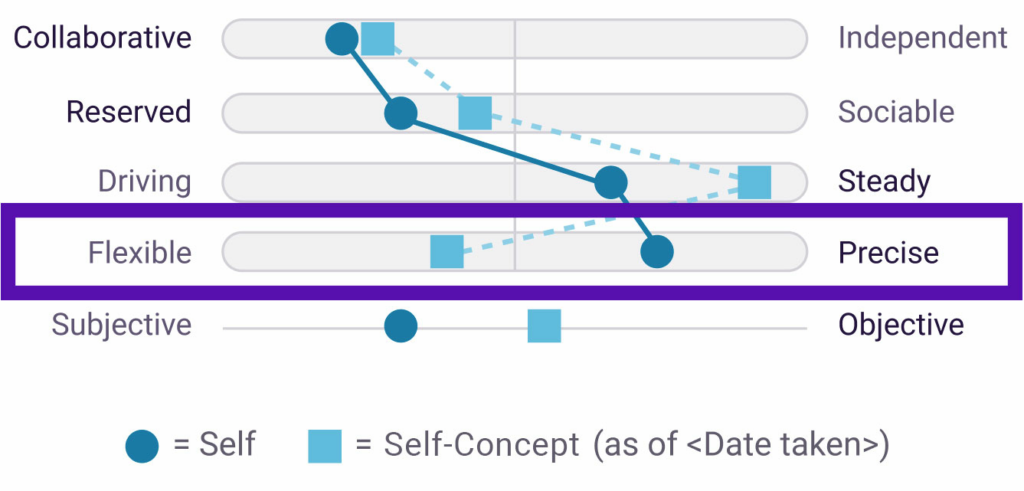
For the most part in the example above, the Self and Self-Concept are aligned. However, this person’s amount of Formality (D) differs from what they think is expected to succeed in the role or what they are currently experiencing. They prefer to be more precise and their Self-Concept shows they feel they need to be more flexible. This may or may not be impacting their performance or their happiness in the role.
Seeing the differences is not enough to make assumptions or jump to any conclusions. The next step is always having a conversation with the employee. The data facilitates conversations around self-awareness, growth, stretching behaviors, or enhancing/improving an individual’s understanding of their role, their team, and what is expected of them at work.
Check the date!
It’s important to note when an employee’s most recent Self-Concept has been assessed, as it may change over time.
Was this page helpful? Spot a typo or inaccuracy? Let us know.
Reference Profiles
Everyone who takes the PI Behavioral Assessment automatically falls under one of our 17 Reference Profiles, which provide a shortcut for understanding behaviors and needs that drive your people. They provide a general idea of a person without having to know the specific amount of Dominance (A), Extraversion (B), Patience (C), or Formality (D) they have.
It all begins with the four factors (the foundation of PI’s methodology) and behavioral insights.
Reference Profiles are created by taking someone’s factor scores and comparing to prototypical Reference Profile patterns. Factor scores are essentially used as coordinates to determine a profile. People fall under whichever prototypical Reference Profile is closest to their pattern.
When you ask someone where they live, they’ll likely tell you the name of an area or neighborhood you might be familiar with. For example, someone from New York City might name one of 5 neighborhoods – the Bronx, Brooklyn, Manhattan, Queens or Staten Island. When they invite you to their house, they’ll give you their exact address.
Reference Profiles are general neighborhoods and behavioral patterns are unique addresses.

You should always refer to a person’s unique behavioral pattern for insight for any process you’re incorporating PI into.
Some Reference Profiles have more variability in their patterns than others. Two people might be Collaborators but still have differences in their patterns. Some patterns might look alike but actually have different Reference Profiles. A person might technically be a Controller, but be close to an Analyzer as well. Or, they might look a lot like an Analyzer, but they’re technically a Controller.
Two patterns might look almost exactly alike but have different Reference Profiles. Not to worry! Remember, the general behavioral characteristics of each Reference Profile still apply to these people. But, this is why you should always take a person’s full pattern into account. Remember, Reference Profiles bring you to a person’s general neighborhood, not their exact house.
To create an even faster way to understand some basic information about Reference Profiles, they’ve been assigned 1 of 4 groups. They are Analytical, Social, Stabilizing, or Persistent. Each group is represented by a different shape. A gear for Analytical, hexagon for Social, triangle for Stabilizing, and circle for Persistent.

ANALYZER | CONTROLLER | SPECIALIST | STRATEGIST | VENTURER
The five Reference Profiles in the analytical group are more dominant than extraverted and have a low amount of patience. People in this group are generally more focused on tasks than people or relationships and tend to work at a fast pace.

ALTRUIST | CAPTAIN | COLLABORATOR | MAVERICK | PERSUADER | PROMOTER
The six Reference Profiles in the social group are all highly extraverted. People with profiles in this group are generally people-oriented and outgoing.

ADAPTER | ARTISAN | GUARDIAN | OPERATOR
The four Reference Profiles in the stabilizing group are less dominant and extraverted while having a high amount of patience and formality. People with profiles in this group are generally steady, detailed, and work well with structure.

INDIVIDUALIST | SCHOLAR
The two Reference Profiles in the persistent group are more dominant than extraverted with a high amount of patience. People with profiles in this group are generally task-oriented and deliberate.
Reference Profiles are descriptive, memorable, and helpful general categories for the 17 different types of behavioral configurations. They make it easy to quickly communicate some standard behavioral traits.
They’re also fun for you and your co-workers. Share your Reference Profile with pride!

The 17 Reference Profiles guide will help you fully understand a person’s needs, behaviors, signature work styles, strengths, common traps, and how to work well with each profile.
Our Manager’s Guide to Reference Profiles provides information on how to motivate and recognize, provide direction and feedback, delegate, and coach each Reference Profile.
A deeper look into each Reference Profile
Looking to find out more information on a specific Reference Profile? Check out one of the following video links to hear the Reference Profile explained by a PI Practitioner.
Translated Reference Profile guides
Was this page helpful? Spot a typo or inaccuracy? Let us know.
Factor Combinations
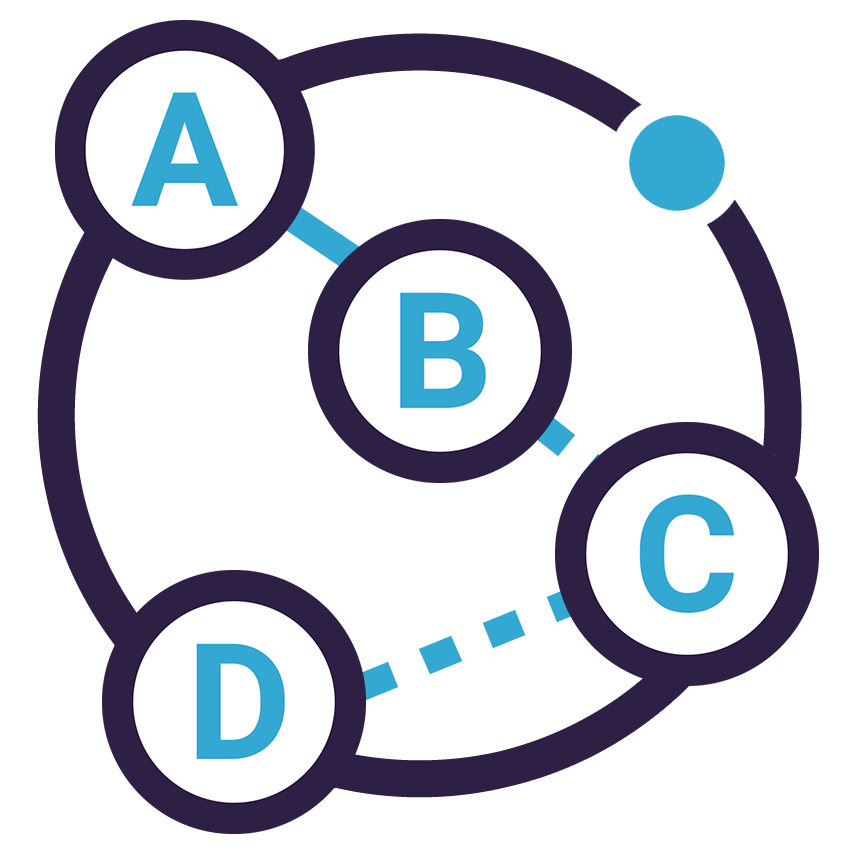
The four factors (A, B, C, and D) measure specific behavioral drives and help us start to understand why we behave the way we do. But, just knowing the factors without looking at how they work together is like learning single notes without learning full chords.
We can learn even more about why people behave the way they do by looking at how two behavioral drives interact. We call these interactions “factor combinations.”
Factor combinations refer to where one factor falls on the pattern in relation to another. It’s the interaction of two different behavioral needs.
Two things contribute to how strongly expressed factor combinations will appear:
- If the factor combination crosses the midpoint (one factor is high and one factor is low).
- If the distance between the two factors is wide. In fact, we advise you to look at the two factors that are the furthest from each other on a person’s pattern.
While we always start with which factors are the widest apart, all of the factor combinations in a pattern can give you further insight. Let’s look at an example for each factor combination.
The A and B factor combination provides insight into whether someone is more task or people oriented. It also gives you information about how people like to communicate, receive information, and interact with people.
- If someone’s A is higher than their B, they’re likely to be more task oriented. The high A means they’re independent and assertive and the low B means they’re analytical and introspective. They’re more direct and focused on completing tasks.
- If someone’s B is higher than their A, they’re likely to be more people oriented. The high B means they’re empathetic and sociable and the low A means they’re collaborative and harmony seeking. They focus on involving people and bringing them together.
The A and C factor combination shows how someone takes action. It helps us understand how quickly someone likes to jump into things and the amount of variety they like to experience.
- If someone’s A is higher than their C, they’re considered proactive. The high A is autonomous and venturesome while the low C is intense and fast-paced. Action is decided and taken quickly.
- If someone’s C is higher than their A, they’re considered responsive. The high C means they’re stable and comfortable with the familiar and the low A means they’re cooperative and accepting. Action is taken with thoughtful and careful consideration.
The A and D factor combination tells us how a person views risk. This helps you understand how much detailed information and how much encouragement a person may need, or how much freedom and opportunities to take risk they want.
- If someone’s A is higher than their D, they’re considered comfortable with risk. The high A means they’re venturesome and competitive while the low D means they’re spontaneous and flexible, so risk is viewed as an exciting challenge or opportunity.
- If someone’s D is higher than their A, they’re considered cautious with risk. The high D means they’re careful, cautious, and diligent, while the low A means they’re deferential and compliant, so risk can be worrisome and cause someone to be more conservative in their approach.
The B and C factor combination tells us if a person establishes a connection with others quickly or if those connections take time.
- If someone’s B is higher than their C, they’re likely quick to connect. The high B means they’re social and enthusiastic while the low C means they’re fast-paced, so connections and relationships are built quickly.
- If someone’s C is higher than their B, they’re likely to take time to connect. The high C means they’re calm and steady while the low b means they’re more reflective and introspective, so connections and relationships are built over time.
The B and D factor combination tells us about how someone interacts with others.
- If someone’s B is higher than their D, they’re informal. The high B means they’re social, expressive, and outgoing and the low D means they’re casual and spontaneous. They’re uninhibited in their friendliness and social interactions.
- If someone’s D is higher than their B, they’re more formal. The high D means they’re serious and reserved and the low B means they’re analytical and introspective. They’ll be more disciplined and cautious with new people.
The C and D factor combination provides insight into how someone views rules.
- If someone’s C is higher than their D, they’re casual with rules. The high C means they’re agreeable and easygoing and the low D means they’re informal and uninhibited, so rules are seen more as guidelines.
- If someone’s D is higher than their C, they’re careful with rules. The high D means they’re precise and thorough and the low C means they’re driving and intense, so they’re concerned with accuracy, punctuality, and adhering to the rules.
A=D Conflict – when Dominance (A) and Formality (D) collide
The Dominance (A) and Formality (D) relationship is all about risk. When the A and D factors are clearly high or low from each other, it’s easy to determine how someone views risk.
But, this factor combination has an extra special relationship, which we call the A=D conflict, which occurs when someone’s A and D are right on top of each other.
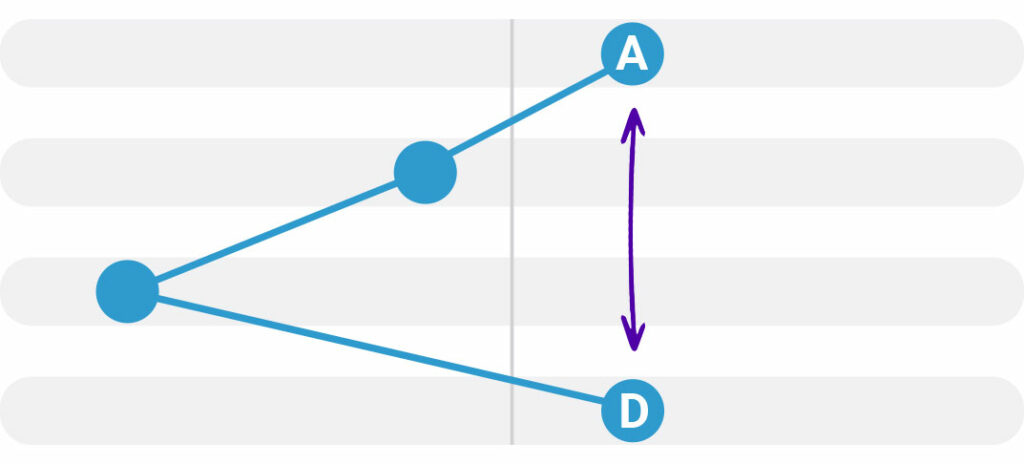
Think about the Dominance (A) factor as a gas pedal and the Formality (D) factor as the brake. When these factors are aligned with each other, it can cause situations where it takes longer for a person to come to a decision because they have their foot on the gas and the brake.
When this happens, the person might need more information, or maybe assistance with narrowing down the options, or also feeling that they have support even if they make an incorrect next step.
Now that you have some insight into Factors and Factor Combinations, there’s one last piece of information that will help you understand your Behavioral Assessment results: Reference Profiles.
Was this page helpful? Spot a typo or inaccuracy? Let us know.
Factors
We all have drives, which create needs. Our behaviors are a response to a need. The PI Behavioral Assessment measures the amount and intensity of the four key behavioral drives to help predict and understand workplace behavior.
After several years of refining, Arnold Daniels created the Predictive Index Behavioral Assessment™ (BA). It was specifically designed to measure four motivating needs, or drives, that had the biggest effect on workplace behaviors: Dominance, Extraversion, Patience, and Formality.
If you know where a person falls for each factor, you possess a great deal of knowledge about what it would be like to work with them.

DOMINANCE: The drive to exert one’s influence on people or events.

EXTRAVERSION: The drive for social interaction with others.

PATIENCE: The drive for consistency and stability.

FORMALITY: The drive to conform to rules or structure.
Everyone has some amount of all four of these drives, which we call factors. Understanding the combination of the four factors and their intensity allows you to, very specifically, describe how a person prefers to communicate, make decisions, delegate, regard rules, and take action. This is your window into how a person prefers to behave.
Once you complete the Behavioral Assessment, you’ll see your Pattern and your Reference Profile.
- Pattern: Think of this as your specific location or address. Your pattern is unique to you and your assessment results.
- Reference Profile: Think of this as your general area or neighborhood. This gives you some basic details about a person without having to know the specific amount of dominance, extraversion, patience, or formality they have.
Factors on a pattern
When you look at your results, you’ll see a pattern like the example below. Factors appear as blue circles and they always appear, from top to bottom, A, B, C, D.
Factors that fall to the left of the midpoint represent a low amount of that particular drive, while those that land to the right of the midpoint represent a high amount.
Since there are no right or wrong responses to the Behavioral Assessment, low and high are neither good nor bad, they’re simply indicators to provide you with language and data to help you better understand a person.
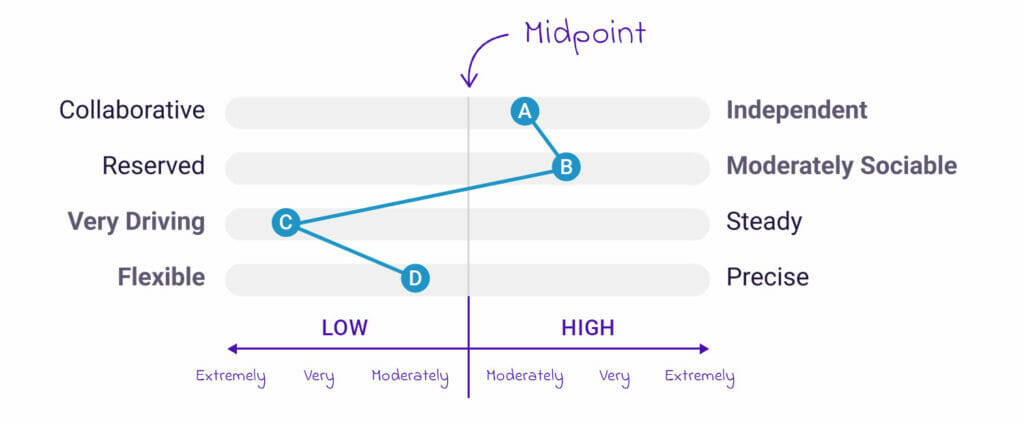
The further away from the midpoint a factor falls, the more forceful the expression of its associated behaviors will be. Because the way a drive is expressed changes depending on the level of that factor, the words we use to describe someone’s behavior change depending on how far their factor is from the midpoint. Let’s explore each one.
In the interactive below, choose which factor (A, B, C, or D) you’d like to learn more about from the left hand side. Then, drag the factor’s icon right or left on the slider to see how the words we use to describe behaviors become stronger or more forcefully expressed the further they are from the midpoint.
Now, drag each factor to the left (low) or right (high) to see descriptions for how these behaviors might show up in the workplace.
Factor E: Subjectivity and Objectivity
You’ll also see Factor E in some areas. This helps describe how what kinds of inputs someone is likely to rely on when making decisions.
How is E different from ABCD?
Factors A, B, C, and D measure the amount of a drive someone has, from extremely low to extremely high. Factor E is used as a secondary, modifying factor because it is not part of the theoretical behavioral model that underpins the primary factors. This means it’s possible to meet two people with the same Pattern who have different decision-making styles. For that reason, Factor E is visualized separately from A, B, C, and D.
Examples:
- If someone has a low C, they have a low amount of Patience. If they have a high C, they have a high amount of Patience.
- If someone has a high D, they prefer a lot of structure. If they have a low D, structure is not a priority.
E is different in that it’s not measuring how little or how much of a drive you have. Rather, it’s telling us if, when it comes time to make a decision, you’ll rely more heavily on subjective or objective information. We show this by putting the factor to the left or right of the midpoint:

- If you see E on the left, it means a person will be more subjective in making decisions. Their ‘gut feeling’ is quite important, and they’re less likely to seek out all sides of the story prior to making decisions. They’ll rely more on what feels right, even if there aren’t numbers to back it up.
- If it’s on the right, they’ll be more objective. They’ll want to examine facts, check sources, and look to the data to guide their decisions.
Sigmas
There are times when you might see numbers and sigma symbols as part of a Behavioral Pattern. Sigmas appear on either side of the midpoint and show how far the person’s factor is from the overall norm sample average. Factor or “sigma” (𝜎) scores represent the standardized scores compared to other people around the world who selected the same number of adjectives.

One sigma range essentially represents one standard deviation from the overall norm sample average. So, if you score farther left than -1.0𝜎 or farther right than 1.0𝜎, it means you are scoring higher than 68% of people for a given factor (conditional on the overall response rate). If you score farther left than -2.0𝜎 or farther right than 2.0𝜎, it means you are scoring higher than 95% of people. If you are in the rare group that scores farther left than -3.0𝜎 or farther right than 3.0𝜎, it means you are scoring higher than 99% of people!
Get even more insights with Factor Combinations

The four factors measure specific behavioral drives and give us a great amount of information on how a person prefers to behave. We can learn even more about why people behave the way they do by looking at how two behavioral drives interact. We call these Factor Combinations.
Was this page helpful? Spot a typo or inaccuracy? Let us know.
